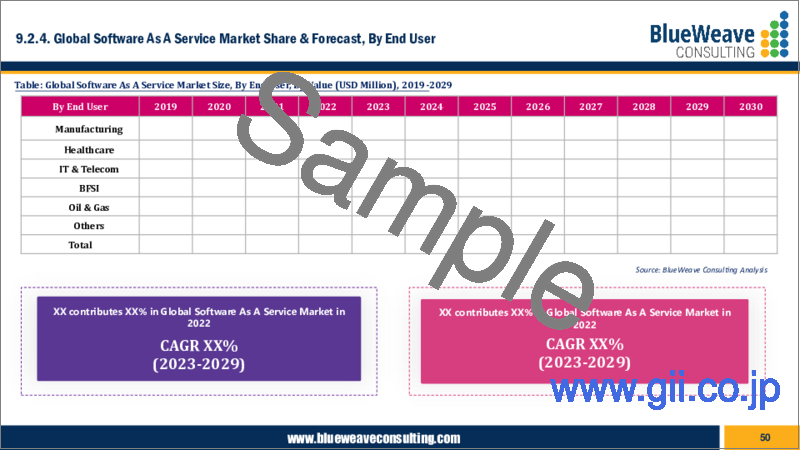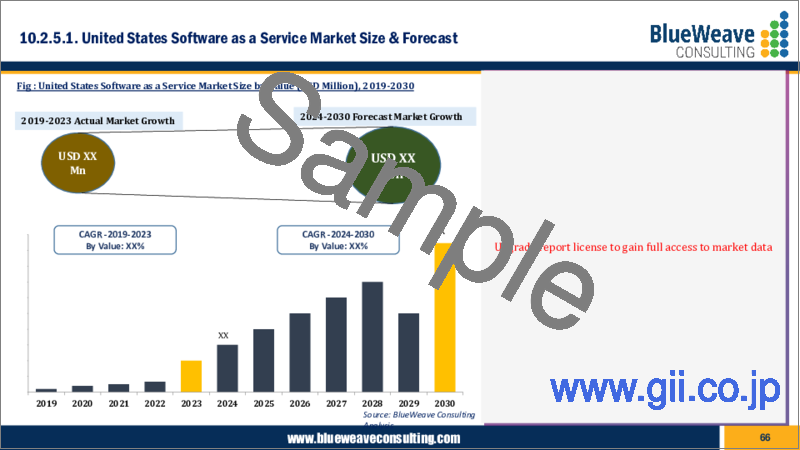|
|
市場調査レポート
商品コード
1301773
SaaS(Software as a Service)市場:世界の市場規模、シェア、動向分析、機会、予測レポート、2019年~2029年Software As a Service Market - Global Size, Share, Trend Analysis, Opportunity and Forecast Report, 2019-2029, Segmented By Solution Type ; By Deployment Model ; By Organization Size ; By Industry Vertical ; By Region |
||||||
|
|||||||
| SaaS(Software as a Service)市場:世界の市場規模、シェア、動向分析、機会、予測レポート、2019年~2029年 |
|
出版日: 2023年06月13日
発行: Blueweave Consulting
ページ情報: 英文 400 Pages
納期: 2~3営業日
|
- 全表示
- 概要
- 目次
SaaS(Software as a Service)の世界市場規模が3.7倍以上に拡大、2029年までに7,900億米ドルに達する
世界のSaaS市場は、SaaSソリューションの拡張性と柔軟性の向上により、企業が変化するビジネスニーズや環境に容易に適応できるようになったこと、デジタルトランスフォーメーションの加速、スマートフォンやアプリベースのサービスの採用が拡大していることから、活況を呈しています。
戦略コンサルティングと市場調査の大手であるBlueWeave Consultingは、最近の調査で、2022年の世界のSaaS市場規模を2,111億2,000万米ドルと推定しました。BlueWeaveは、2023年から2029年にかけての予測期間中、SaaSの世界市場規模はCAGR 16.36%で堅調に成長し、2029年には7,892億3,000万米ドルに達すると予測しています。世界のSaaS市場の主な成長促進要因としては、スマートデバイスの利用増加、ビジネスアウトソーシングを促進するパブリッククラウドやハイブリッドクラウドソリューションの採用拡大などが挙げられます。スマートデバイスの需要はエンドユーザーの間で高まっており、主にインスタントメッセージングアプリ、電子メール、ビデオコミュニケーションプラットフォームの普及がその要因となっています。こうした要因が、SaaS市場の好調な軌道をさらに後押ししています。また、ITコストを最小限に抑え、拡張性を向上させるために、顧客関係管理(CRM)のSaaSソリューションを採用する企業も増えています。CRMのSaaSソリューションでは、ユーザーフレンドリーなカスタマイズや設定オプションが利用できるため、企業はCRMシステムをセキュリティ要件などの特定のニーズに合わせてカスタマイズすることができます。このような要因が、予測期間における世界のSaaS市場の成長を促進すると予想されます。しかし、SaaSプラットフォームソリューションの導入とメンテナンスに関連する高コストは、市場全体の成長を抑制すると予測されています。
本レポートの詳細な分析により、世界のSaaS市場の成長可能性、今後の動向、統計に関する情報を提供します。また、総市場規模の予測を促進する要因にも注目しています。当レポートは、世界のSaaS市場の最新技術動向や、意思決定者が戦略的な意思決定を行う際に役立つ業界インサイトを提供することをお約束します。さらに、市場の成長促進要因・課題・競争力についても分析しています。
目次
第1章 調査の枠組み
第2章 エグゼクティブサマリー
第3章 世界のSaaS市場の洞察
- 業界のバリューチェーン分析
- DROC分析
- 成長の原動力
- SaaSソリューションの拡張性と柔軟性により、企業はビジネスの変化に容易に適応
- スマートフォンやアプリベースのサービスの普及が進む
- 世界中で企業のデジタルトランスフォーメーションが加速
- 抑制要因
- SaaSプラットフォームソリューションの導入と保守に伴う高額なコスト
- 機会
- 事業の地理的拡大によるビジネスモデルソフトウェアの急速な変化
- ビジネスにおけるSaaSプラットフォームの新たな動向
- 課題
- 業界内でのセキュリティとプライバシーへの懸念の増加
- 成長の原動力
- 技術の進歩/最近の開発
- 規制の枠組み
- ポーターのファイブフォース分析
第4章 世界のSaaS市場概要
- 市場規模と金額別予測、2019~2029年
- 金額別
- 市場シェアと予測
- ソリューションの種類別
- 顧客関係管理(CRM)
- エンタープライズリソースプランニング(ERP)
- サプライチェーンマネジメント(SCM)
- 運営管理
- 人事管理(HRM)
- その他
- 展開モデル別
- プライベートクラウド
- パブリッククラウド
- ハイブリッドクラウド
- 組織規模別
- 中小企業
- 大企業
- 業種別
- BFSI
- 製造業
- IT・通信
- 小売・eコマース
- エネルギー・ユーティリティ
- ヘルスケア
- メディア・エンターテインメント
- その他
- 地域別
- 北米
- 欧州
- アジア太平洋(APAC)
- ラテンアメリカ(LATAM)
- 中東およびアフリカ(MEA)
- ソリューションの種類別
第5章 北米のSaaS市場
- 市場規模と金額別予測、2019~2029年
- 金額別
- 市場シェアと予測
- ソリューションの種類別
- 展開モデル別
- 組織規模別
- 業種別
- 国別
- 米国
- カナダ
第6章 欧州のSaaS市場
- 市場規模と金額別予測、2019~2029年
- 金額別
- 市場シェアと予測
- ソリューションの種類別
- 展開モデル別
- 組織規模別
- 業種別
- 国別
- ドイツ
- 英国
- イタリア
- フランス
- スペイン
- ベルギー
- ロシア
- オランダ
- その他欧州
第7章 アジア太平洋のSaaS市場
- 市場規模と金額別予測、2019~2029年
- 金額別
- 市場シェアと予測
- ソリューションの種類別
- 展開モデル別
- 組織規模別
- 業種別
- 国別
- 中国
- インド
- 日本
- 韓国
- オーストラリアとニュージーランド
- インドネシア
- マレーシア
- シンガポール
- フィリピン
- ベトナム
- その他APAC
第8章 ラテンアメリカのSaaS市場
- 市場規模と金額別予測、2019~2029年
- 金額別
- 市場シェアと予測
- ソリューションの種類別
- 展開モデル別
- 組織規模別
- 業種別
- 国別
- ブラジル
- アルゼンチン
- ペルー
- その他LATAM
第9章 中東およびアフリカのSaaS市場
- 市場規模と金額別予測、2019~2029年
- 金額別
- 市場シェアと予測
- ソリューションの種類別
- 展開モデル別
- 組織規模別
- 業種別
- 国別
- サウジアラビア
- アラブ首長国連邦
- カタール
- クウェート
- 南アフリカ
- ナイジェリア
- アルジェリア
- その他MEA
第10章 競合情勢
- 主要企業とその製品のリスト
- 世界のSaaS企業の市場シェア分析、2022年
- 動作パラメータによる競合ベンチマーキング
- 主要な戦略的開発(合併、買収、パートナーシップなど)
第11章 世界のSaaS市場に対するCOVID-19の影響
第12章 企業プロファイル(会社概要、財務マトリックス、競合情勢、主要な人材、主要な競合、連絡先住所、戦略的展望、 SWOT分析)
- Alphabet Inc.
- Amazon
- Microsoft Corporation
- IBM Corporation
- Salesforce Inc.
- SAP SE
- Oracle Corporation
- Cisco Systems, Inc
- Hewlett Packard Enterprise Company
- ServiceNow, Inc.
- Other Prominent Players
第13章 主要な戦略的推奨事項
第14章 調査手法
Global Software as a Service (SaaS) Market Size Zooming More Than 3.7X to Touch Whopping USD 790 Billion by 2029
Global software as a service (SaaS) market is flourishing because of an increasing scalability and flexibility of SaaS solutions enable companies to easily adapt to changing business needs and environment, acceleration of digital transformation, and growing adoption of smart phones and app-based services.
BlueWeave Consulting, a leading strategic consulting and market research firm, in its recent study, estimated global software as a service (SaaS) market size at USD 211.12 billion in 2022. During the forecast period between 2023 and 2029, BlueWeave expects global software as a service (SaaS) market size to grow at a robust CAGR of 16.36% reaching a value of USD 789.23 billion by 2029. Major growth drivers for the global software as a service (SaaS) market include an increasing usage of smart devices and the growing adoption of public and hybrid cloud solutions, which facilitate business outsourcing. The demand for smart devices is rising among end-users, primarily driven by the widespread use of instant messaging apps, emails, and video communication platforms. These factors further contribute to the positive trajectory of the SaaS market. Also, businesses are increasingly adopting Customer Relationship Management (CRM) Software-as-a-Service (SaaS) solutions to minimize IT costs and improve scalability. The availability of user-friendly customization and configuration options for CRM SaaS solutions allows businesses to tailor their CRM systems to specific needs, including security requirements. These factors are expected to drive the growth of the global software as a service (SaaS) market in the forecast period. However, high costs associated with implementation and maintenance of SaaS platform solution are anticipated to restrain the overall market growth.
Global Software as a Service (SaaS) Market - Overview:
Software as a Service (SaaS) is a software licensing and delivery model where software is licensed on a subscription basis and centrally hosted. It is also referred to as "on-demand software." SaaS operates as a cloud-based service, allowing users to access the software through a web browser instead of downloading and installing it on local devices or networks. The advantages of SaaS include accessibility, compatibility, and streamlined operational management. Moreover, the SaaS model offers lower upfront costs compared to traditional software downloads and installations, making it accessible to a wider range of businesses. This accessibility empowers smaller companies to disrupt existing markets while enabling suppliers. The two primary deployment models for SaaS are the public cloud and private cloud. The public cloud involves third-party management of on-demand computing services and shared infrastructure over the internet, catering to customer relationship management, enterprise resource planning, human resource management, manufacturing and operations, and supply chain management needs of small, medium, and large businesses. Various industries, such as manufacturing, retail, education, healthcare, IT and telecom, and BFSI, leverage SaaS for their operations.
Impact of COVID -19 on Global Software as a Service (SaaS) Market
COVID-19 pandemic had a positive impact on the global Software as a Service (SaaS) market. As organizations rapidly shifted to remote work models, the demand for cloud-based SaaS solutions soared. Companies heavily relied on SaaS applications for collaboration, communication, and workflow management. The pandemic also accelerated digital transformation initiatives, leading to increased adoption of SaaS across various sectors. However, the economic downturn caused by the pandemic has created budget constraints for some businesses, affecting their ability to invest in SaaS solutions. Also, supply chain disruptions and market uncertainties have posed challenges for SaaS providers.
Global Software as a Service (SaaS) Market - By Organization Size:
Based on organization size, the global software as a service (SaaS) market is bifurcated into Small & Medium-sized Enterprises (SMEs) and Large Enterprises segments. The large enterprises segment dominated the global software as a service (SaaS) market in 2022. This segment benefits from various advantages offered by SaaS solutions, including cost-effectiveness, scalability, and flexibility. Large enterprises are increasingly adopting multi-cloud and hybrid-cloud strategies to effectively manage complex distributed application environments across different geographies, data centers, and cloud providers. Moreover, the adoption of platform as a service (PaaS) solutions is another noticeable trend among large enterprises. PaaS solutions provide a higher level of abstraction, allowing enterprises to focus on application development and deployment without the burden of managing underlying infrastructure. This approach enables large enterprises to expedite time-to-market, reduce development costs, and enhance agility and innovation. Meanwhile, the small and medium enterprises (SMEs) segment is projected to witness substantial growth throughout the forecast period. The on-demand consumption model of SaaS has brought about a revolution in the IT landscape, leading to rapid SaaS adoption among SMEs in recent years. The cost-effectiveness, accessibility, and scalability of SaaS have made it an appealing choice for SMEs, as they often have limited budgets and cannot afford the upfront capital investment and ongoing expenses associated with traditional IT infrastructure. By embracing SaaS, SMEs gain access to powerful software applications and services that would otherwise be financially out of reach. This enables them to compete more effectively with larger businesses, boost productivity, and drive overall growth.
Competitive Landscape:
Major players operating in the global software as a service (SaaS) market include: Alphabet Inc., Amazon, Microsoft Corporation, IBM Corporation, Salesforce Inc., SAP SE, Oracle Corporation, Cisco Systems, Inc., Hewlett Packard Enterprise Company, and ServiceNow, Inc. To further enhance their market share, these companies employ various strategies, including mergers & acquisitions, partnerships, joint ventures, license agreements, and new product launches.
The in-depth analysis of the report provides information about growth potential, upcoming trends, and statistics of Global Software as a Service (SaaS) Market. It also highlights the factors driving forecasts of total market size. The report promises to provide recent technology trends in Global Software as a Service (SaaS) Market and industry insights to help decision-makers make sound strategic decisions. Furthermore, the report also analyzes the growth drivers, challenges, and competitive dynamics of the market.
Table of Contents
1. Research Framework
- 1.1. Research Objective
- 1.2. Product Overview
- 1.3. Market Segmentation
2. Executive Summary
3. Global Software as a Service (SaaS) Market Insights
- 3.1. Industry Value Chain Analysis
- 3.2. DROC Analysis
- 3.2.1. Growth Drivers
- 3.2.1.1. The scalability and flexibility of SaaS solutions enable companies to easily adapt to changing business
- 3.2.1.2. Rise in adoption of smart phones and app-based services
- 3.2.1.3. Acceleration of digital transformation among enterprises, globally
- 3.2.2. Restraints
- 3.2.2.1. High cost associated with implementation and maintenance of SaaS platform solution
- 3.2.3. Opportunities
- 3.2.3.1. Rapid changes in business model software, owing to geographical expansion of businesses
- 3.2.3.2. Emerging trends of SaaS platform in businesses
- 3.2.4. Challenges
- 3.2.4.1. Increase in security & privacy concerns among the industry vertical
- 3.2.1. Growth Drivers
- 3.3. Technological Advancements/Recent Developments
- 3.4. Regulatory Framework
- 3.5. Porter's Five Forces Analysis
- 3.5.1. Bargaining Power of Suppliers
- 3.5.2. Bargaining Power of Buyers
- 3.5.3. Threat of New Entrants
- 3.5.4. Threat of Substitutes
- 3.5.5. Intensity of Rivalry
4. Global Software as a Service (SaaS) Market Overview
- 4.1. Market Size & Forecast by Value, 2019-2029
- 4.1.1. By Value (USD Billion)
- 4.2. Market Share & Forecast
- 4.2.1. By Solution Type
- 4.2.1.1. Customer Relation Management (CRM)
- 4.2.1.2. Enterprise Resource Planning (ERP)
- 4.2.1.3. Supply Chain Management (SCM)
- 4.2.1.4. Operation Management
- 4.2.1.5. Human Resource Management (HRM)
- 4.2.1.6. Others
- 4.2.2. By Deployment Model
- 4.2.2.1. Private Cloud
- 4.2.2.2. Public Cloud
- 4.2.2.3. Hybrid Cloud
- 4.2.3. By Organization Size
- 4.2.3.1. Small & Medium-sized Enterprises (SMEs)
- 4.2.3.2. Large Enterprises
- 4.2.4. By Industry Vertical
- 4.2.4.1. BFSI
- 4.2.4.2. Manufacturing
- 4.2.4.3. It & Telecom
- 4.2.4.4. Retail & Ecommerce
- 4.2.4.5. Energy & Utilities
- 4.2.4.6. Healthcare
- 4.2.4.7. Media & Entertainment
- 4.2.4.8. Others
- 4.2.5. By Region
- 4.2.5.1. North America
- 4.2.5.2. Europe
- 4.2.5.3. Asia Pacific (APAC)
- 4.2.5.4. Latin America (LATAM)
- 4.2.5.5. Middle East and Africa (MEA)
- 4.2.1. By Solution Type
5. North America Software as a Service (SaaS) Market
- 5.1. Market Size & Forecast by Value, 2019-2029
- 5.1.1. By Value (USD Billion)
- 5.2. Market Share & Forecast
- 5.2.1. By Solution Type
- 5.2.2. By Deployment Model
- 5.2.3. By Organization Size
- 5.2.4. By Industry Vertical
- 5.2.5. By Country
- 5.2.5.1. United States
- 5.2.5.1.1. By Solution Type
- 5.2.5.1.2. By Deployment Model
- 5.2.5.1.3. By Organization Size
- 5.2.5.1.4. By Industry Vertical
- 5.2.5.2. Canada
- 5.2.5.2.1. By Solution Type
- 5.2.5.2.2. By Deployment Model
- 5.2.5.2.3. By Organization Size
- 5.2.5.2.4. By Industry Vertical
6. Europe Software as a Service (SaaS) Market
- 6.1. Market Size & Forecast by Value, 2019-2029
- 6.1.1. By Value (USD Billion)
- 6.2. Market Share & Forecast
- 6.2.1. By Solution Type
- 6.2.2. By Deployment Model
- 6.2.3. By Organization Size
- 6.2.4. By Industry Vertical
- 6.2.5. By Country
- 6.2.5.1. Germany
- 6.2.5.1.1. By Solution Type
- 6.2.5.1.2. By Deployment Model
- 6.2.5.1.3. By Organization Size
- 6.2.5.1.4. By Industry Vertical
- 6.2.5.2. United Kingdom
- 6.2.5.2.1. By Solution Type
- 6.2.5.2.2. By Deployment Model
- 6.2.5.2.3. By Organization Size
- 6.2.5.2.4. By Industry Vertical
- 6.2.5.3. Italy
- 6.2.5.3.1. By Solution Type
- 6.2.5.3.2. By Deployment Model
- 6.2.5.3.3. By Organization Size
- 6.2.5.3.4. By Industry Vertical
- 6.2.5.4. France
- 6.2.5.4.1. By Solution Type
- 6.2.5.4.2. By Deployment Model
- 6.2.5.4.3. By Organization Size
- 6.2.5.4.4. By Industry Vertical
- 6.2.5.5. Spain
- 6.2.5.5.1. By Solution Type
- 6.2.5.5.2. By Deployment Model
- 6.2.5.5.3. By Organization Size
- 6.2.5.5.4. By Industry Vertical
- 6.2.5.6. Belgium
- 6.2.5.6.1. By Solution Type
- 6.2.5.6.2. By Deployment Model
- 6.2.5.6.3. By Organization Size
- 6.2.5.6.4. By Industry Vertical
- 6.2.5.7. Russia
- 6.2.5.7.1. By Solution Type
- 6.2.5.7.2. By Deployment Model
- 6.2.5.7.3. By Organization Size
- 6.2.5.7.4. By Industry Vertical
- 6.2.5.8. The Netherlands
- 6.2.5.8.1. By Solution Type
- 6.2.5.8.2. By Deployment Model
- 6.2.5.8.3. By Organization Size
- 6.2.5.8.4. By Industry Vertical
- 6.2.5.9. Rest of Europe
- 6.2.5.9.1. By Solution Type
- 6.2.5.9.2. By Deployment Model
- 6.2.5.9.3. By Organization Size
- 6.2.5.9.4. By Industry Vertical
7. Asia-Pacific Software as a Service (SaaS) Market
- 7.1. Market Size & Forecast by Value, 2019-2029
- 7.1.1. By Value (USD Billion)
- 7.2. Market Share & Forecast
- 7.2.1. By Solution Type
- 7.2.2. By Deployment Model
- 7.2.3. By Organization Size
- 7.2.4. By Industry Vertical
- 7.2.5. By Country
- 7.2.5.1. China
- 7.2.5.1.1. By Solution Type
- 7.2.5.1.2. By Deployment Model
- 7.2.5.1.3. By Organization Size
- 7.2.5.1.4. By Industry Vertical
- 7.2.5.2. India
- 7.2.5.2.1. By Solution Type
- 7.2.5.2.2. By Deployment Model
- 7.2.5.2.3. By Organization Size
- 7.2.5.2.4. By Industry Vertical
- 7.2.5.3. Japan
- 7.2.5.3.1. By Solution Type
- 7.2.5.3.2. By Deployment Model
- 7.2.5.3.3. By Organization Size
- 7.2.5.3.4. By Industry Vertical
- 7.2.5.4. South Korea
- 7.2.5.4.1. By Solution Type
- 7.2.5.4.2. By Deployment Model
- 7.2.5.4.3. By Organization Size
- 7.2.5.4.4. By Industry Vertical
- 7.2.5.5. Australia & New Zealand
- 7.2.5.5.1. By Solution Type
- 7.2.5.5.2. By Deployment Model
- 7.2.5.5.3. By Organization Size
- 7.2.5.5.4. By Industry Vertical
- 7.2.5.6. Indonesia
- 7.2.5.6.1. By Solution Type
- 7.2.5.6.2. By Deployment Model
- 7.2.5.6.3. By Organization Size
- 7.2.5.6.4. By Industry Vertical
- 7.2.5.7. Malaysia
- 7.2.5.7.1. By Solution Type
- 7.2.5.7.2. By Deployment Model
- 7.2.5.7.3. By Organization Size
- 7.2.5.7.4. By Industry Vertical
- 7.2.5.8. Singapore
- 7.2.5.8.1. By Solution Type
- 7.2.5.8.2. By Deployment Model
- 7.2.5.8.3. By Organization Size
- 7.2.5.8.4. By Industry Vertical
- 7.2.5.9. Philippines
- 7.2.5.9.1. By Solution Type
- 7.2.5.9.2. By Deployment Model
- 7.2.5.9.3. By Organization Size
- 7.2.5.9.4. By Industry Vertical
- 7.2.5.10. Vietnam
- 7.2.5.10.1. By Solution Type
- 7.2.5.10.2. By Deployment Model
- 7.2.5.10.3. By Organization Size
- 7.2.5.10.4. By Industry Vertical
- 7.2.5.11. Rest of APAC
- 7.2.5.11.1. By Solution Type
- 7.2.5.11.2. By Deployment Model
- 7.2.5.11.3. By Organization Size
- 7.2.5.11.4. By Industry Vertical
8. Latin America Software as a Service (SaaS) Market
- 8.1. Market Size & Forecast by Value, 2019-2029
- 8.1.1. By Value (USD Billion)
- 8.2. Market Share & Forecast
- 8.2.1. By Solution Type
- 8.2.2. By Deployment Model
- 8.2.3. By Organization Size
- 8.2.4. By Industry Vertical
- 8.2.5. By Country
- 8.2.5.1. Brazil
- 8.2.5.1.1. By Solution Type
- 8.2.5.1.2. By Deployment Model
- 8.2.5.1.3. By Organization Size
- 8.2.5.1.4. By Industry Vertical
- 8.2.5.2. Argentina
- 8.2.5.2.1. By Solution Type
- 8.2.5.2.2. By Deployment Model
- 8.2.5.2.3. By Organization Size
- 8.2.5.2.4. By Industry Vertical
- 8.2.5.3. Peru
- 8.2.5.3.1. By Solution Type
- 8.2.5.3.2. By Deployment Model
- 8.2.5.3.3. By Organization Size
- 8.2.5.3.4. By Industry Vertical
- 8.2.5.4. Rest of LATAM
- 8.2.5.4.1. By Solution Type
- 8.2.5.4.2. By Deployment Model
- 8.2.5.4.3. By Organization Size
- 8.2.5.4.4. By Industry Vertical
9. Middle East & Africa Software as a Service (SaaS) Market
- 9.1. Market Size & Forecast by Value, 2019-2029
- 9.1.1. By Value (USD Billion)
- 9.2. Market Share & Forecast
- 9.2.1. By Solution Type
- 9.2.2. By Deployment Model
- 9.2.3. By Organization Size
- 9.2.4. By Industry Vertical
- 9.2.5. By Country
- 9.2.5.1. Saudi Arabia
- 9.2.5.1.1. By Solution Type
- 9.2.5.1.2. By Deployment Model
- 9.2.5.1.3. By Organization Size
- 9.2.5.1.4. By Industry Vertical
- 9.2.5.2. UAE
- 9.2.5.2.1. By Solution Type
- 9.2.5.2.2. By Deployment Model
- 9.2.5.2.3. By Organization Size
- 9.2.5.2.4. By Industry Vertical
- 9.2.5.3. Qatar
- 9.2.5.3.1. By Solution Type
- 9.2.5.3.2. By Deployment Model
- 9.2.5.3.3. By Organization Size
- 9.2.5.3.4. By Industry Vertical
- 9.2.5.4. Kuwait
- 9.2.5.4.1. By Solution Type
- 9.2.5.4.2. By Deployment Model
- 9.2.5.4.3. By Organization Size
- 9.2.5.4.4. By Industry Vertical
- 9.2.5.5. South Africa
- 9.2.5.5.1. By Solution Type
- 9.2.5.5.2. By Deployment Model
- 9.2.5.5.3. By Organization Size
- 9.2.5.5.4. By Industry Vertical
- 9.2.5.6. Nigeria
- 9.2.5.6.1. By Solution Type
- 9.2.5.6.2. By Deployment Model
- 9.2.5.6.3. By Organization Size
- 9.2.5.6.4. By Industry Vertical
- 9.2.5.7. Algeria
- 9.2.5.7.1. By Solution Type
- 9.2.5.7.2. By Deployment Model
- 9.2.5.7.3. By Organization Size
- 9.2.5.7.4. By Industry Vertical
- 9.2.5.8. Rest of MEA
- 9.2.5.8.1. By Solution Type
- 9.2.5.8.2. By Deployment Model
- 9.2.5.8.3. By Organization Size
- 9.2.5.8.4. By Industry Vertical
10. Competitive Landscape
- 10.1. List of Key Players and Their Offerings
- 10.2. Global Software as a Service (SaaS) Company Market Share Analysis, 2022
- 10.3. Competitive Benchmarking, By Operating Parameters
- 10.4. Key Strategic Development (Mergers, Acquisitions, Partnerships, and others)
11. Impact of Covid-19 on Global Software as a Service (SaaS) Market
12. Company Profile (Company Overview, Financial Matrix, Competitive landscape, Key Personnel, Key Competitors, Contact Address, Strategic Outlook, and SWOT Analysis)
- 12.1. Alphabet Inc.
- 12.2. Amazon
- 12.3. Microsoft Corporation
- 12.4. IBM Corporation
- 12.5. Salesforce Inc.
- 12.6. SAP SE
- 12.7. Oracle Corporation
- 12.8. Cisco Systems, Inc
- 12.9. Hewlett Packard Enterprise Company
- 12.10. ServiceNow, Inc.
- 12.11. Other Prominent Players
13. Key Strategic Recommendations
14. Research Methodology
- 14.1. Qualitative Research
- 14.1.1. Primary & Secondary Research
- 14.2. Quantitative Research
- 14.3. Market Breakdown & Data Triangulation
- 14.3.1. Secondary Research
- 14.3.2. Primary Research
- 14.4. Breakdown of Primary Research Respondents, By Region
- 14.5. Assumptions & Limitations





